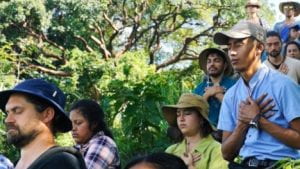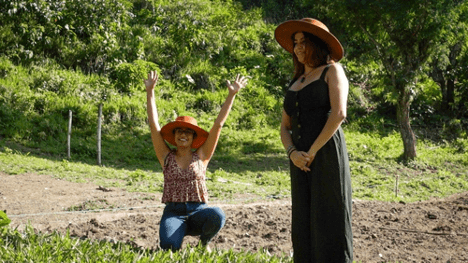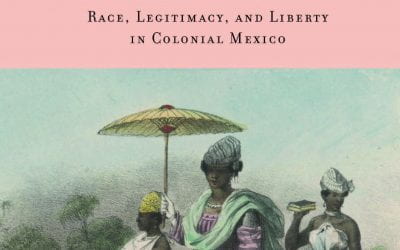Broken Land
Climate Change and Migration in Guatemala
Santos Istazuy Pérez (right) sits in meditation during a group hike and workshop at a lush farm along with fellow Guatemalans and like-minded people from around the world including Germany and Uruguay. Photo by Jessica Marcy, 2021.
QUETZALTENANGO, Guatemala— Santos Istazuy Pérez walks into an empty, coral-colored classroom at El Centro de Apoyo Familiar (Family Support Center), decorated with characters from the film “Inside Out.” The words “Utz Petem,” (“welcome”) in Maya K’iche’ and the characters—Joy, Fear, Anger, Sadness, Disgust— invite young students to learn and express their emotions. These days the room is not filled with the sound of children, but rather with the blare of construction. The sounds reflect the fact that Guatemalan migrants in the United States are sending remittances to build homes nearby.
Slender with glasses, Pérez works as the education coordinator at a local non-profit called 32 Volcanes in Pérez’s hometown Llano del Pinal. It’s a 20-minute drive from Quetzaltenango, the country’s second largest city, a three-and a half hour drive northwest of the capital, Guatemala City.
Children haven’t been coming to the center for classes since it closed its doors following the first case of Covid-19 in Guatemala on March 15, 2020. Instead, the students have been learning online at home, often challenged by unreliable or nonexistent Internet. That has frustrated and overwhelmed some students and further enticed them to migrate north.
Despite the pandemic-induced stress of online-learning, Pérez lights up when he talks about teaching young children about the Maya K’iche’ language, culture and traditional agriculture.
“Many things have been brought in from other cultures that do not belong to us and yet we are not realizing that we are losing our own. My motivation has always been education,” Pérez said. He believes education must be informed by history.
The number of unaccompanied minors migrating to the United States has risen in recent years with more people leaving Guatemala in part because of the effects of climate change, which has increased crop failures and environmental disasters.
The pandemic has further exacerbated the area’s challenges, increasing malnutrition, poverty, unemployment and school disruption and drop-out rates, which has pushed even more young people to migrate. Unlike some of his colleagues, Pérez has chosen to stay and work with 32 Volcanes, which has also been squeezed by financial pressures from the pandemic.
Santos Istazuy Pérez (second left) writes on a poster during a weekly planning meeting at 32 Volcanes. Photo by Jessica Marcy. Guatemala, 2021.
Carmen Benítez, a medical doctor, serves as co-director of 32 Volcanes, which provides holistic programs in agriculture, education, health and nutrition and arts and culture in Quetzaltenango and surrounding, largely Indigenous communities in the western highlands. She emphasizes the connection between migration and a host of other issues such as food insecurity.
“If people are not having even water or food, they are going to leave because it’s the only way to escape a dramatic context. It is sometimes the only path,” Benítez said.
Guatemala is part of the Dry Corridor, an area in Central America marred by failed harvests and food insecurity from unpredictable rain patterns that cause both severe drought and flooding. In recent years, the effects of climate change have further fueled migration. From 2015 to 2018, people left because of drought. Later, in 2020, two hurricanes—Iota and Eta—hit within a span of two weeks, causing flooding and landslides in Alta Verapaz. Those events also pushed people to leave.
Benítez stresses the connection between political and economic interests and environmental degradation, explaining that short-sighted economic growth has incentivized the destruction of the Earth’s resources. She points out that in Guatemala, weak democracy and government have permitted the expansion of food monocultures, such as palm oil or potatoes for export. The heavy use of toxic chemical fertilizers in combination with food monoculture practice has led to soil degradation. Likewise, mineral extraction like mining has led to erosion, deforestation, decreased water supply and soil contamination. Such factors make the soil and land less resilient to the effects of climate change. The western highlands is an area known for its microclimates, making it even more sensitive to climate and weather variation.
She says that instead of having people risk their lives to migrate, she wants them to stay, collaborate and regenerate the ecosystem and environment. She explains the importance of valuing the Mayan cosmovision, which teaches that there is an intrinsic connection between humans, nature and the universe.
“If we lose that connection, we will get sick,” Benítez said. “Most of all, we’re trying to change the economic, cultural, health and food paradigm that we are facing right now with climate change and global warming.”
Started in 2019, 32 Volcanes builds on programs that Benítez’s parents, an anthropologist and a social worker, started almost three decades earlier during the country’s civil war. Collective memory is central to the organization, which recognizes the lingering inequalities created by colonialism. That legacy still affects land ownership and agricultural production today as smaller Indigenous farmers are often displaced by large agricultural businesses and extractive companies.
32 Volcanes uses “regenerative development” to go beyond sustainable development and create new models that not only protect the environment, but renew and enhance it. Regeneration, she explains, seeks to address development challenges exacerbated by climate change, such as degraded farmland and decreased biodiversity. 32 Volcanes’ approach is to create resiliency and equitable prosperity long-term by combining ancestral knowledge with innovation. Part of their innovative approach is the use of a cryptocurrency called Seeds that harkens back to how the Mayans used physical seeds as a medium of exchange and places value on locally grown products like cacao and activities that restore nature like replanting trees.
Carmen Benítez (left) sings during a workshop alongside her sister Carmen Maria Benítez (right). Carmen Benítez, a medical doctor, is co-founder of 32 Volcanes, a local community organization. Carmen Maria Benítez is a psychologist and Waldorf teacher who manages education and mental health programs at 32 Volcanes. Photo by Jessica Marcy. Guatemala, 2021.
The scholarship program, one the oldest programs run by 32 Volcanes, is an example of the organizations’ long-term approach to resiliency and equity. Scholarships help families with the financial costs related to education at the primary, secondary and university level. More than a hundred scholars receive about $170 annually to cover items such as registration fees, school supplies and books. In turn, family members are required to participate in monthly meetings about diverse topics, ranging from nutrition to domestic violence.
Scholars like Pérez are now becoming leaders in the organization and catalysts for regeneration in their own communities. When he was eight years old, he received a scholarship to support his own studies through the program started by Benítez’s parents. Now 26, he has completed a master’s degree in bilingual education in Maya K’iche’ and Spanish. The oldest son in his family, Pérez encouraged his siblings to also pursue scholarships. Now, they all work together at 32 Volcanes; his mother as the cook, two sisters part-time in the education program and another sister in the pharmacy. They are regularly seen cooking and happily chatting together in the kitchen at 32 Volcanes.
Benítez says the number of unaccompanied minors leaving Guatemala has risen dramatically since 32 Volcanes started. She points to UNICEF data that the number of migrant children and teens staying in Mexican migrant shelters increased nine-fold from 380 to nearly 3,500 in the first three months of 2021. Most of the young migrants in the shelters come from Honduras, Guatemala, El Salvador and Mexico. They are either waiting to cross into the United States or have just returned after being deported.
In July 2021, the monthly number of migrant encounters at the U.S.-Mexico border soared to a 21-year high with over 200,000 encounters referring to the number of interactions between undocumented migrants and U.S. Border Patrol officers. There was also a record number of unaccompanied minors—19,000 at the border during the first 29 days of July, according to a federal filing.
In November 2021, apprehensions at the southwest U.S. border rose again for the first time since the apex in July, increasing by more than 5 percent from the previous month and representing the largest influx for November in years. That was due to across-the-board increases, including unaccompanied minors, and was driven in part by a steady stream of arrivals from Central America, the largest number of whom are Guatemalans, according to the U.S. Customs and Border Protection (U.S. CBP) data.
The U.S. CBP reported 14,167 encounters of unaccompanied children at the U.S.-Mexico border in March of 2022 alone. UNICEF estimates that if the policy known as Title 42 which restricts entrance to the United States during a pandemic is lifted, there could be between 12,000 to 18,000 migrants arriving at the U.S.-Mexico border daily. Those numbers represent a tripling of the current rate of overall migrant arrivals.
Guatemala is key to the Biden administration’s migration policy. During her first official foreign visit in June 2021, U.S. Vice President Kamala Harris sent a clear message to would-be migrants, “Do not come.”
Still, young people continue to leave Guatemala, and large numbers flee the Western Highlands. Forty years ago, Quetzaltenango used to be the country’s industrial center with lots of good car manufacturing and other production jobs. When those opportunities dried up, people left with them and remittances became a lifeline for many families.
“Today we have a titanic task to solve for young people and children,” said Juan Fernando López, the mayor of Quetzaltenango, who was also a migrant in the United States for five years.
Both Benítez and Pérez say that despite the intervention of 32 Volcanes, some young scholarship recipients still decide to migrate because of economic and other reasons.
“Every time that we know that someone is leaving, it’s not only frustration, it’s historical pain. And, it hurts a lot,” Benítez said, fighting back tears of frustration. “It hurts because they are family, who are my family as well, people who have worked with me and I’ve been working with them. And, sometimes we get angry because of the parents letting children leave their country and go alone without any protection.”
Dry cracks in the land reveal the effects of drought and climate change. Photo by Amelia Tyson. Guatemala, 2021.
Antonia Xuruc, who manages environmental projects for the Western Rural Development Cooperation Association (C.D.R.O.), says it’s critical to combine ancestral community knowledge with climate science to effectively confront climate change and ensure that harvests are fruitful. For instance, Indigenous Mayan teachings explain how to plant and harvest according to the lunar phase for optimal results while climate science can warn about upcoming threats to crops such as frosts or flooding.
In the face of climate change, 32 Volcanes looks for solutions in models of regeneration like the ones found in nature. Inside its headquarters, clay jars line the walls and hold ancestral seeds that are native to the area and are more resilient. Cacao and health products are sold onsite and people are encouraged to purchase them with the cryptocurrency Seeds. They also organized a full-day workshop at a lush farm where local staff collaborated with people associated with Seeds from as far away as Uruguay and Germany.
“We are linked and connected in a way that is not subjective. We are working together. This is not a revolution, this is the renaissance of humanity and the Earth,” Benítez said.
Those working with 32 Volcanes can also act as “pollinators” or people who have been trained to a sufficient degree that they can transfer their environmental and ancestral knowledge to a community. The learning is not one way, pollinators also learn from the community where they work. Pérez serves as a pollinator in Llano del Pinal, which is surrounded by mountains that are cut up from mining and serves as the trash dump for Quetzaltenango as seen in the plastic bags and discarded shoes that haphazardly dot the land. The area has experienced deforestation, landslides, and drought, which causes crops to die.
32 Volcanes uses traditional farming methods like a huerto mandala, or circular mandala-shaped community garden, to combat agricultural degradation. Photo by Jessica Marcy. Guatemala, 2021.
With the Santa María volcano behind him, Pérez sits inside a circular mandala-shaped community garden as mist gently passes in the distance. The garden uses an ancestral Mayan agricultural technique that distributes water throughout concentric circles, from the medicinal plants in the very center to the maize, broad beans and amaranth on the outer rings. The practice protects humidity and also decreases the risk of plagues and drought. The circular shape is also symbolic of the universe, showing that what happens in the heavens should also happen on Earth and reflecting how the Earth circles the Sun and the moon circles the Earth, he explains.
Pérez guides children and their parents to care for the garden, teaching them how to identify the plants, make organic fertilizer and cultivate crops, as well as sing songs. Protecting Mother Earth is central to Mayan belief and he tries to instill that respect and care in the children he teaches.
32 Volcanes is named after the number of sacred volcanoes, which symbolize ancestral memory and strength, in Guatemala. In the mandala garden, Pérez explains how the Santa Maria volcano behind him was originally called Gagxanul in Maya K’iche’, but was renamed by the Spaniards after their conquest and massacre of the Indigenous communities.
“We call them our guardians because they have persisted during battles, they have persisted and they have seen our history, so they are our guardians and they represent us. It is part of our culture, it is part of our identity,” Pérez said about the volcanoes. Pérez estimates that perhaps five percent of young Guatemalans share his desire to recuperate and value Indigenous culture, which he says is very difficult because of racism and discrimination.
Despite such challenges, Pérez, Benítez and 32 Volcanes continue to reimagine a more abundant future for Guatemala where young people choose to create opportunity at home. They recently reopened their educational center in Pérez’s hometown in April 2022.
“My hope, my objective, my desire is to be able to sow that little seed in the hearts of the children we serve, not only in them, but in all the people we work with,” Pérez said. “But to sow that little seed of solidarity, to be able to help each other and to be able to persevere in this struggle that we have, to be able to persevere.”
The documentary can be seen at: https://pulitzercenter.org/stories/broken-land-confronting-climate-change-and-migration-guatemala
Jessica Marcy is a filmmaker and journalist who is focused on social issues and connections across cultures and the environment. She is a 2021 campus consortium fellow with the Pulitzer Center on International Crisis Reporting and won the 2022 Visions Award for best graduate narrative short script for “Khadijah’s Magical Books” at American University. She holds a BA in Latin American Studies from Barnard College, a MS in journalism from Columbia University, and a MFA in film at American University.
Amelia Tyson is a graduate of American University with an MFA in documentary filmmaking. She is the American University 2022 Vision Awards winner for her graduate thesis film, “Meet A Participant | Aylene”. She is a 2021 campus consortium fellow with the Pulitzer Center on International Crisis Reporting. She focuses her storytelling on narratives that emphasize human connection, whether it be stories of migration or the environment.
Related Articles
Editor’s Letter – Eyes on COVID-19
Editor's Letter Documenting Covid-19 It’s been two years, two months and some days since we published Olivia Liendo’s powerful article “With Covid-19, We are All Immigrants.” Relating how friends, family and strangers came together to help her mother in Venezuela...
A Review of The Rebel Scribe: Carleton Beals and the Progressive Challenge to U.S. Policy in Latin America
This is how the adventure of the 25-year-old from Kansas begins: “I began to dream dreams, extravagant dreams. I would stay here in this city of the Aztecs and the Conquistadors ..
A Review of The Capital of Free Women: Race, Legitimacy, and Liberty in Colonial Mexico
Ever since James Lockhart published Spanish Peru in 1968, historians of colonial Latin America have mined the notarial archives to illuminate the daily lives of people who were largely…








